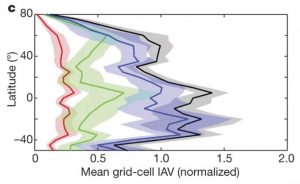J. A. Hobmayer
The role of water in the upcoming years of climate change is not as widely discussed as the developing trend of temperature changes around the globe. Although it could be very helpful, no it will be very helpful for further measures to secure our freshwater reservoirs or understand the change in the hydrologic cycle.
Climatic dependencies on water
The ability of water to store engergy or release it by warming up or cooling down should be already known. The aquatic masses of our globe function as some kind of thermic buffer – flattening and slowing down extrem temperatur variations on a seasonal and daily scale. The evaporative cooling -resulting from the evaporation of water- is also an important climatic factor for our continents. But because of water limitation there is also a physical limitation – increased warming can only sustain higher evaporation when the water supply can keep up. How much we depend on this effect can be seen in the arid and therefore more hostile and species-poor regions. Studies of climate models show that the climate change will probably lead to decreasing water storages – even affecting ground water reservoirs.
The fundamental need for freshwater does not only include the need for drinking water, but rather the possibility to ensure agriculture and plantgrowth in general. If this predicted trend of drying subsurfaces and increasing ground water depths should come true, it could affect whole ecosystems – their productivity and diversity. Although climate models vary and the drying is very likely shown to be heterogen at a local level -depending on the geological circumstances of a certain region, there is defenitely a global trend of increasing aridity visible. But where is it then? Where is the water going? Legitimate questions considering the fact that we live in this kind of self contained biotope. Probably there will be a rise of humidity in the atmosphere, maybe even a water shift from the inland towards the oceans or to more humid regions.
Whereby the -in the past- widely accepted theory that dry land gets drier and wet gets wetter is just in a few cases undeniably proven to be true. Understanding the impact of climate change on the hydrology of a certain region seem to be much more complicated. Although there could be something like a vicious circle of increasing heat, leading to a drier surface that is less able to cool down by evaporation chill.
Water cycle affecting the carbon cycle
Furthermore considering respiration, plantgrowth means much more to living creatures than beeing a primary producer of food, especially for the human race. About one quater of anthroprogenetic emissions are sequestered by terrestrial ecosystems every year. The major share is clearly dominated by highly productive land, like the tropical rainforests. But possible interannual anomalies in this so called carbon sink, that could be observed over the last decades are very likely originating in semi-arid ecosystems, mainly in semi arid systems that are largely occupying low latitudes. Maybe because of interannual variations in the water supply of these regions? It has to be some kind of circulation driven force, maybe an interaction of both temperature and precipation.
Analysing data could show indeed the importance of existing water reservoirs for the ability of a certain ecosystem to be highly productive and able to maintain photosynthesis. On a local scale water availability is by far the overall dominant driver, and through its own variations responsible for interannual variations of carbon dioxid uptake. The two differences to this phenomenon on a global scale are the compensation of photosynthesis versus respiration and the compensation in space. Meaning that dry and productive regions tend to cancel each other out, if the data is mathematically integrated. So nothing to worry about? Surely not, if we think about the the already mentioned facts. As discussed before, it is very likely that surfaces and subsurfaces on average will get drier in the future. Meaning that we will probably lose parts of our carbon storage too. Additionally, higher temperatures are believed to be leading to less photosynthesis and more respiration.

Figure 45.1 – Fig.: Showing the interannual variations (IAV) of different climatic components. To illustrate data at a local level, all land surfaces were splitted up into grid cells of a certain size. Within cells of the same attitude was then the mean manignitude of variations calculated. Revealing how interannual variations of radiation (red), temperature (green) or water availability (blue) are affecting variations of the net carbon dioxide uptake (black). Water is clearly confirmed to be the dominant factor at a local scale. (graphic based on a FLUXCOM model)
How to prevent all of the described effects? Clearly the most important action is fighting climate change and so getting to the root of the problem. Possible future measures are especially needed on drying ecosystems and on freshwater supply in arid regions. But the effort it might need to turn things around and the scale of technology and infrastructure we may have to use is fully depending on the impact of climate change.
And if we want to prevent or create.
References:
Jung, M., Reichstein, M., Schwalm, C. et al. Compensatory water effects link yearly global land CO2 sink changes to temperature. Nature 541, 516–520 (2017). https://doi.org/10.1038/nature20780
Condon, L.E., Atchley, A.L. & Maxwell, R.M. Evapotranspiration depletes groundwater under warming over the contiguous United States. Nat Commun 11, 873 (2020). https://doi.org/10.1038/s41467-020-14688-0
Ahlström, A., Raupach, M. R., Schurges, G. et al. The dominant role of semi-arid ecosystems in the trend and variability of the land CO2 sink
Science 22, MAY: 895-899 (2015). https://science.sciencemag.org/content/348/6237/895
Greve, P., Orlowsky, B., Mueller, B. et al. Global assessment of trends in wetting and drying over land. Nature Geosci 7, 716–721 (2014). https://doi.org/10.1038/ngeo2247
Illustration:
Jung, M., Reichstein, M., Schwalm, C. et al. Compensatory water effects link yearly global land CO2 sink changes to temperature. Nature 541, 516–520 (2017). https://doi.org/10.1038/nature20780
Media Attributions
- How carbon uptake is affected